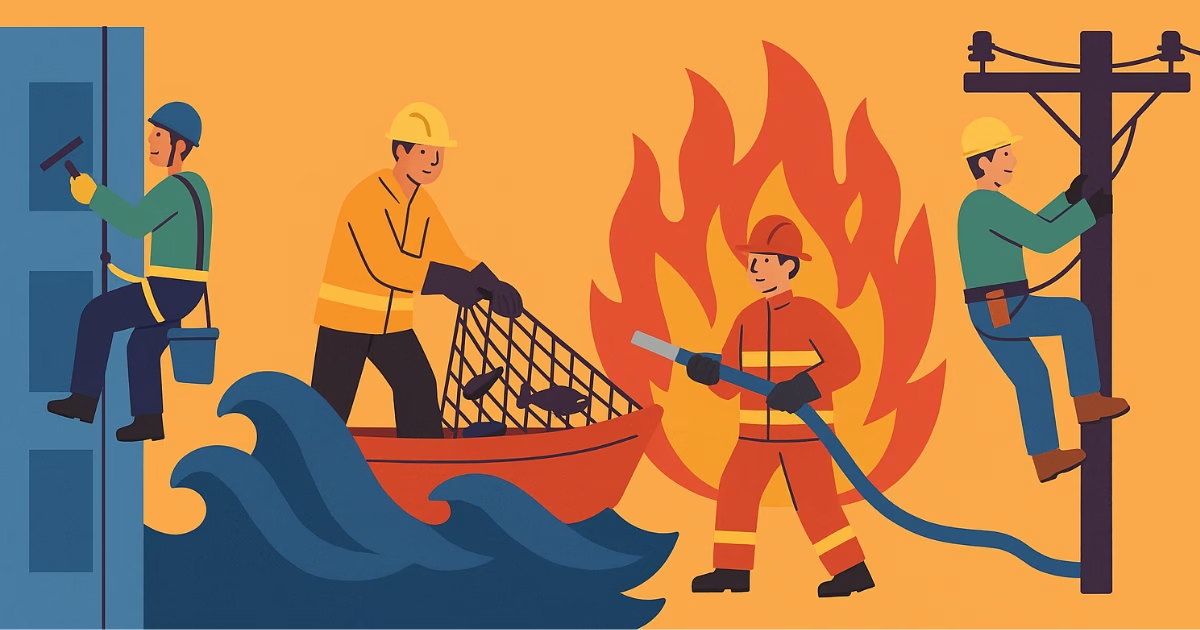Around the world, countless people work in roles that most of us can hardly imagine. While many of us sit safely at desks or work indoors, others face life-threatening challenges every single day just to earn a living. From scaling skyscrapers to braving violent seas, these workers take on incredible risks as part of their jobs.
The highest risk jobs in the world come with dangers that can’t always be controlled — hazardous equipment, unpredictable weather, or even violent encounters. Understanding these jobs is not just about curiosity; it’s about recognizing the courage and sacrifice that go into them. By looking closely at these occupations, we gain a new level of respect for those who put their lives on the line and help keep industries and societies running, often without the public noticing.
Understanding the Highest Risk Jobs in the World
The highest risk jobs in the world are not just about danger. They often combine tough conditions, unpredictable environments, and tasks where one mistake can mean disaster. These jobs may involve working at extreme heights, with heavy machinery, in violent areas, or in remote places.
What makes a job dangerous? Factors like exposure to severe weather, handling dangerous tools, or working in isolated areas all play a role. For example, loggers work with chainsaws near falling trees, while deep-sea fishermen battle massive waves.
According to global data, industries like logging, fishing, and construction report some of the highest fatality and injury rates. These are not just numbers — they reflect real people facing real risks every day. Understanding why these jobs are so hazardous helps us appreciate the safety improvements that protect workers and the bravery it takes to do these roles.
Top 10 Highest Risk Jobs in the World
1. Logging Workers
Logging is widely ranked as one of the deadliest jobs worldwide. Workers use chainsaws and heavy equipment to cut down massive trees, often in remote forests. The risks include being crushed by falling trees, struck by branches, or injured by machinery.
Slippery terrain and unpredictable weather only make things worse. A small misstep can have serious consequences. Despite safety gear and training, fatal accidents still happen too often in this industry.
2. Deep-Sea Fishermen
Deep-sea fishermen face freezing waters, brutal storms, and heavy nets on slippery decks. Shows like Deadliest Catch have revealed the harsh reality behind this work.
One wrong move can send someone overboard, and survival rates in icy waters are low. Equipment malfunctions and long, exhausting shifts add to the danger. It’s no surprise fishing has one of the highest fatality rates in the world.
3. Roofers
Roofing may seem simple, but it’s surprisingly deadly. Workers spend long hours at dangerous heights, often under the blazing sun or in unpredictable weather.
The biggest risk? Falls. Even with safety harnesses, slips happen. A misjudged step or unstable surface can lead to serious injury or death. Roofing jobs also often involve power tools and materials that add extra hazards.
4. Construction Workers
Construction workers face a mix of dangers daily — heavy equipment, sharp tools, exposed wiring, and heights.
Cranes can malfunction, scaffolding can collapse, and trenches can cave in. Accidents happen not only from equipment but also from poor planning or miscommunication on busy sites. While safety training has improved, construction still ranks high on global fatality lists.
5. Miners
Miners work underground, facing cave-ins, gas explosions, and dangerous chemicals. Coal miners, in particular, are exposed to black lung disease from dust particles.
Mining is not only physically hard but mentally stressful. Workers often operate in tight, dark spaces, sometimes miles below the surface. Even small mistakes can trigger large-scale disasters.
6. Pilots (Bush Pilots, Crop Dusters)
While commercial airline pilots enjoy relatively safe careers, small aircraft pilots — especially bush pilots and crop dusters — face serious risks.
They fly in rough weather, over remote areas, and often have to land on short or improvised runways. Mechanical failures, bad visibility, and sudden weather changes make this job particularly dangerous.
7. Firefighters
Firefighters run toward danger while everyone else runs away. They face burning buildings, smoke, collapsing structures, and even explosions.
Heat exhaustion, falling debris, and toxic gases are daily risks. Despite improved gear and training, firefighters continue to put their lives on the line to save others.
8. Oil and Gas Workers
Offshore oil rigs and onshore drilling sites are some of the most hazardous workplaces. Explosions, fires, equipment malfunctions, and extreme weather are constant threats.
Oil and gas workers often work long shifts far from help. The 2010 Deepwater Horizon disaster is a tragic reminder of how deadly this work can become.
9. Police Officers and Soldiers
Police officers and soldiers face violence, armed attacks, and life-threatening confrontations.
They often work under extreme stress, where split-second decisions can mean life or death. Beyond combat or crime scenes, they also deal with physical strain, mental health challenges, and unpredictable dangers.
10. Electric Power Line Workers
Working on power lines, often high off the ground, exposes line workers to electrocution, falls, and extreme weather.
Even routine repairs can turn deadly if equipment fails or safety rules are missed. These workers play a critical role in keeping power grids running, often after storms or disasters when conditions are at their worst.
Why People Choose High-Risk Jobs
Given the dangers, why do people take on these jobs? For some, it’s about money — high-risk jobs often pay better to attract workers. For others, it’s a sense of purpose, duty, or adventure.
Some grow up in families or regions where these jobs are common. Others simply want the challenge or adrenaline rush. While not everyone understands their motivation, the workers themselves often take pride in what they do.
How Safety Measures Reduce Risks
Thankfully, safety measures have come a long way. Industries now focus on better training, equipment, and regulations. Helmets, harnesses, flame-resistant clothing, and other protective gear save countless lives.
Governments set strict rules, and companies invest in advanced technologies to monitor conditions and prevent accidents. Still, no system is perfect. Human error, equipment failure, or natural disasters can always strike.
Also Read: Top Dangerous Jobs in the World: Risky Careers Revealed
Final Thoughts on the Highest Risk Jobs in the World
The highest risk jobs in the world remind us that many people put their safety on the line every day to keep society running. From the food we eat to the electricity we use, these workers are behind it all.
Recognizing their sacrifices means valuing their contributions and supporting better safety and fair pay. As we go about our daily lives, it’s worth remembering the unseen heroes working dangerous jobs that benefit everyone.
FAQ
What is the deadliest job in the world?
Logging is often ranked as the most dangerous job, with the highest fatality rate.
How do workers stay safe in risky jobs?
Through training, protective gear, teamwork, and following strict safety procedures.
Are high-risk jobs paid more?
Often yes, but not always. Some offer hazard pay or bonuses, but others pay modest wages despite the danger.

Hi, I’m Shafy Ali – a curious mind and passionate writer at Celiac Magazine. I cover a little bit of everything, from everyday tips and how-tos to deeper dives into topics that spark conversation. I enjoy turning research into readable, relatable content that informs and inspires. Whatever the subject, I aim to keep it clear, engaging, and genuinely useful.

